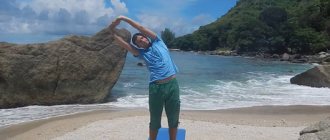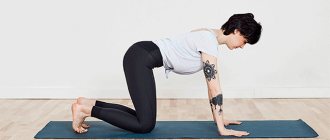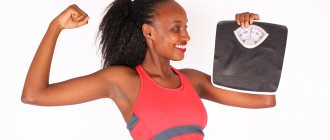Do you dream of a flat tummy? It is possible to achieve amazing results. You will need to regularly perform the asanas, which we will look at below, as well as a little patience and diligence. The complex is aimed at working the abdominal muscles, helping to strengthen the body and improve the functioning of internal organs.
Almost all exercises are aimed at normalizing metabolism and removing toxins from the body. However, priority asanas for a flat stomach should be highlighted.
Asanas for a flat stomach
Candle pose (Skt. Salamba Sarvanasana), popularly known as “birch tree”
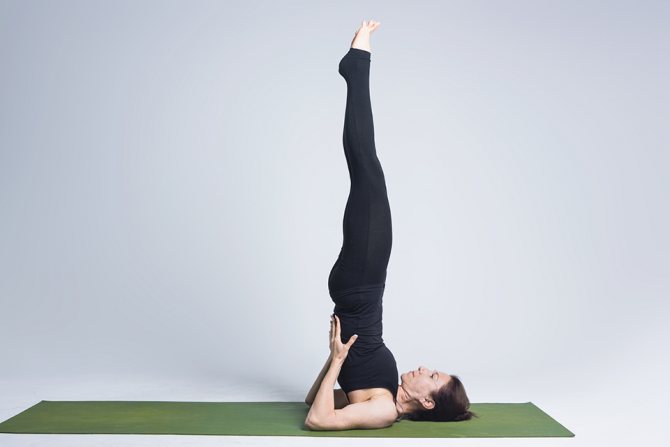
Improves blood circulation and the functioning of the internal organs of the abdominal cavity. Metabolism is normalized and harmful toxins are not retained in the body. We say, “Goodbye, fat! Goodbye cellulite!
- For convenience, place the folded blanket on the floor and lie down. The head and almost the entire neck lie on the floor behind the blanket.
- Bend your knees and slowly pull them toward your chest.
- Straighten your legs and carefully lift them up. Don't forget to support your heel with your hands.
- Lift your back off the ground. The legs slowly fall behind the head. The spine is as straight as possible.
- Freeze in position for 2-4 minutes. Don't forget to breathe. Slow and deep breaths, smooth exhalations.
- We straighten our legs and pull them towards the sun (up). While standing on your shoulders and forearms, do not forget to breathe evenly and support the stance with your hands in the lumbar region. We freeze for 5-7 minutes, after which we slowly lower our lower limbs.
To perform a simplified version of Candle Pose, use a chair. Lower your legs behind your head onto a pre-prepared chair.
Stretch pose (Skt. Uttanasana)
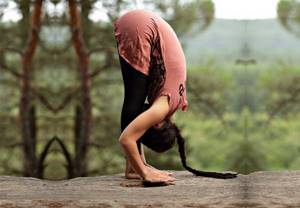
Feel how your abdominal muscles strengthen and your back muscles stretch. Each organ of the abdominal cavity is rejuvenated, calmed, and relaxed. The asana helps burn fat in the abdominal area. The figure takes on a proportional appearance.
- Align the body, stand straight, breathe evenly. Legs slightly apart.
- The knees are absolutely straight. The kneecaps are slightly pulled up.
- As you inhale, straighten your arms smoothly rise up.
- We bend our arms and grab our elbows.
- Smoothly lower your body down until it stops. Don't overdo it. Your body will still open up and show what it is capable of.
- Gently stretch your forehead to your knees and remain in this position for 2-4 minutes. The knees are straight, the head and elbows are as low as possible.
Head on Knee Pose (Sk. Janu Sirsasana)
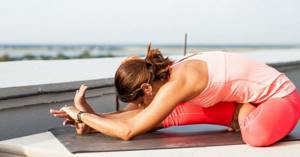
Liver function improves, the spleen is stimulated, and digestion improves. The muscles of the lower back are noticeably strengthened and the stomach goes away. A straight back trains the abs and rids the body of fat. Excess weight can be easily lost with the help of twisting and inverted asanas.
- We sit down on a previously used blanket (towel). The left leg is positioned directly in the direction of view, and the right leg is bent at the knee, pressing the foot to the groin area.
- Let's take a slow breath, raising our arms towards the sun, and as we exhale, bend towards our left leg. Try to bend down as low as possible and grab the foot of the outstretched leg with your hands.
- The leg is as straight as possible, breathing is even, the forehead reaches towards the knee of the left leg. We sway with light movements of the body forward and backward. Finally, they stopped and froze in a pose for several minutes.
- Repeat the asana with your right leg.
Yoga poses for beginners. Basic complex of asanas
Downward Facing Dog Pose
One of the basic yoga poses for beginners. Get on all fours, placing your hands on the floor with your palms approximately shoulder-width apart. Straighten your knees and push your pelvis up, while slightly arching your lower back and straightening your arms. Try staying in this yoga pose for beginners for 30 seconds. Gradually increase the time of the asana to 1 minute.
This asana relieves tension from the spine, hips and buttocks. If you have been sitting in the office all day, it will relieve heaviness and pain in the lower back, neck, and gluteal muscles.
Standing Forward Bend pose
This pose is classified as a set of basic asanas for beginners. Stand straight with your feet together. As you exhale, bend forward as low as possible, keeping your legs straight. Lower your arms freely. Touch them to the floor if you can. If this is easy, try touching your hands to the floor behind your feet. Stay in this position for about a minute.
Asana for beginners is needed to relieve tension from the back muscles, tone the hips and buttocks.
Inverted_candle pose
Viparita Karani
often translated as “Bent Candle Pose.” Meanwhile, “viparita” literally means “upside down,” and “karani” means “in action.” This means that all the actions that occur inside us in a normal state, when we stand or sit, flow in the opposite direction in this asana.
An inverted position is good for the body. Firstly, it promotes the drainage of lymph, the excess of which causes swelling in the ankles, tired knees or tension in the pelvic organs. Secondly, inverted poses improve blood supply to the brain.
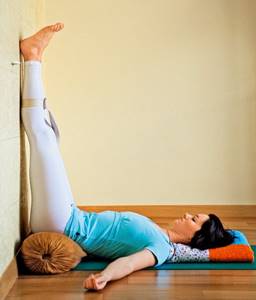
This pose is ideal for relaxing, relieving stress and feeling tired after a long flight. The point of the pose is to do less, not more - this is the only way to achieve a positive effect. In this asana you do not need to work hard as usual. Viparita Karani offers a completely different understanding of what work is - both in yoga and in everyday life. Its virtues come not only from the inverted position, but also from the reverse understanding of what the action is. When you relax in a lying position and stretch your legs along the wall, you are practicing an activity that is about receptivity.
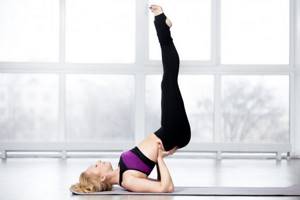
As soon as you start practicing yoga regularly, inverted asanas become part of a mandatory ritual. Their miraculous power is spoken of in the ancient treatise “Hatha Yoga Pradipika”, where Viparita Karani (translated from Sanskrit as “reverse process”) is called “conquering old age and death.” The outstanding yoga guru BKS Iyengar also considered inverted poses to be among the most beneficial in their effects on the body. What is the essence of this benefit? Let's figure it out.
To begin with, let’s define that inverted asanas include all asanas during which the head is lower than the pelvis. These include Sarvangasana (aka Birch or Candle), Viparita Karani mudra (Bent Candle), Shirshasana (headstand), Halasana (Plow pose) and others. As a rule, these asanas are performed at the very end of the class, before Shavasana.
While we are on our feet, our body is constantly fighting the effects of gravity. The weight of the body, day after day, year after year, puts pressure on the spine and joints, reducing the layer of soft tissue between them. The muscles are constantly tense, helping the joints keep the body upright and preventing tissue from sagging. The heart and blood vessels work continuously, dispersing blood throughout the body, down and up, despite the force of gravity. Over the years, it becomes more and more difficult for us to wage this tireless struggle. By turning upside down, we seem to be deceiving gravity, unloading the body and reversing the processes.
Benefits for the body
Staying in an inverted asana for 2-5 minutes significantly facilitates the flow of bodily fluids through the venous and lymphatic channels of the lower extremities, as well as the abdominal and pelvic organs. Inverted poses stimulate the lymphatic system and accelerate lymph flow, facilitating the process of cleansing the body. To enhance the drainage effect, it is useful to combine inverted asanas with uddiyana bandha and dynamic movements of the feet (rotation, stretching in one direction and the other).
Inversions stimulate venous blood flow to the heart from the legs and torso much more effectively and safely than dynamic training and running. Thanks to this property, inverted asanas can and should be used in the treatment of varicose veins, hemorrhoids, fluid stagnation and other diseases of the circulatory and lymphatic systems of the body.
You may have noticed that in an inverted position of the body, pressure, arterial and eye, increases significantly. However, when holding a pose for a long time, the so-called parasympathetic “brake” is activated: the body begins to “think” that the brain is receiving too much blood, and “orders” the heart and circulatory system to compensate for this, lowering blood pressure. The resulting powerful calming effect can be used in the prevention of hypertension, stroke, heart attack and some kidney diseases. However, if you have serious illnesses (high blood pressure, cardiovascular diseases, intraocular pressure disorders), you should consult your doctor before performing inverted asanas.
Sarvangasana (candle pose). Effects
During the performance of svarvangasana, attention and blood circulation are concentrated in the area of the thyroid and parathyroid glands, respectively, the shoulder stand affects these organs. In practice, there is no more effective method for improving the functioning and treatment of thyroid diseases than performing sarvangasana. However, the effect of this asana is not limited to these organs only.
Candle pose is a classic hatha yoga exercise and affects the entire body, all organs and systems.
During the shoulder stand, the deltoid muscles, as well as the external and internal back muscles, are stretched. In addition, due to the fact that the chin rests on the chest, the function of the endocrine glands is normalized and stimulated.
According to many years of observations made at the Yoga Institute in Bombay, regular practice of sarvangasana gave positive effects for constipation, dyspepsia, hepatitis, headaches, and dizziness. And also for diseases of the eyes, nose, throat, ears.
In addition, the candle pose is effective for hemorrhoids and varicose veins. Studies have shown that pain in the legs decreases after shoulderstand, and with regular and correct practice of this asana, the veins return to normal.
This asana is very useful for people who work while standing (salespeople, hairdressers, builders,...). They can be recommended to perform sarvangasana at the end of the working day (necessarily before meals, on an empty stomach), and if possible, then during breaks during work.
Shoulderstand is also useful for young people during puberty, because... helps avoid wet dreams in young men if performed before bed.
Sarvangasana (candle pose) or shoulder stand
Sarvangasana (candle pose) is one of the wonderful and widely known yoga exercises.
This asana is also known by other names - “birch tree”, shoulder stand or head stand. The very name “sarvangasana” literally translates as the pose of all members or the pose of all parts (of the body), which speaks quite eloquently about the complex effect of this asana on the entire body. And some yoga authorities claim that no set of exercises will be effective without this pose.
No other exercise other than headstand (sirshasana) improves blood circulation in the head as much as sarvangasana (candle pose). Accordingly, its effect on the human body is in many ways similar to a headstand. However, there are also differences.
Five miracles will happen if you do this simple inverted pose effortlessly every day!
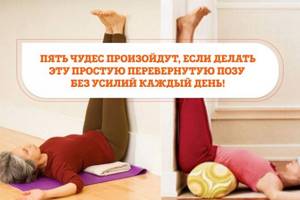
This golden rule is worth taking as a habit. In the evening, at the end of a grueling day, you need to lie down against the wall, raise your legs up and spend 10 to 15 minutes in this position. No additional equipment, just your legs and the wall. It is advisable to do this every day.
Just below there will be a video showing how to correctly take the bent candle pose . The exercise is very easy, accessible to everyone, no matter how old you are! I’ve been doing this for a couple of months now; I’ll tell you a little about the result this simple technique gives.
I have a tendency to swell my legs and my legs get tired quickly. Finding comfortable shoes is quite difficult due to the enlarged bones on the feet. I spend the whole day at work at the computer and in the evening I feel absolutely exhausted: if I don’t have the opportunity to work out or take a walk after work, my body feels like it’s alien due to prolonged sitting, I feel heaviness in my head and terrible lethargy.
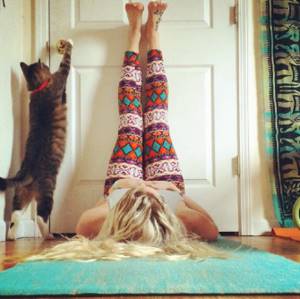
When I learned about this exercise, of course, curiosity arose: how is it possible, you don’t need to do anything, you just lie against the wall and enjoy a therapeutic procedure for the whole body? Can't be. It turns out that this basic yoga pose can actually do magic.
Once you spend at least 5 minutes in this position, it’s as if you are reborn. Fatigue goes away, the body comes to life and invigorates, the head becomes clear. Thanks to this static exercise, you can still do a lot of things in the evening, your body becomes toned, and your legs feel light. I'm delighted with the effect!
Why is it so beneficial to lift your legs up the wall? During the day, our body is constantly in an upright position; the most harmful thing is to sit. Thanks to this accessible pose, the body will take a position opposite to its usual one.
This pose with a calm soul can be called the most powerful prevention of varicose veins . During its implementation, venous outflow improves, swelling of the legs disappears, and the feeling of fatigue goes away. In addition, it alleviates the suffering of those who already know what a misfortune it is to have diseased veins.
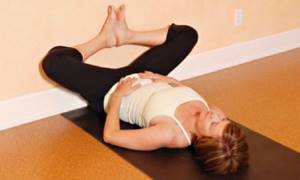
How to do Bent Candle Pose correctly
- In yoga, this simple asana is called Viparita Karani. It is believed that when a person stands on his feet, he ages, but in an inverted position, all the processes of the body go backwards, and he becomes younger. The maximum benefit will be if you are in this pose in silence .
- Lie on your back with your hips about 30cm away from the wall. Bend your knees and place your feet on the wall. Make sure your hips are at right angles to the wall.
- Straighten your legs, lean their entire surface against the wall, keep your knees straight, relax your legs. Who would have thought that preventing varicose veins on the legs is so simple.
- Place a pillow under your head, it should be very comfortable. Close your eyes and breathe deeply. Place one palm on your stomach, the other on your heart.
- Become aware of your breathing, inhale for 2 counts, exhale for 4 counts. Try to stop the internal dialogue, calm your thoughts, listen only to your breathing.
This point is especially important for those who often experience stress at work, feel anxious, or have insomnia. Calm, conscious breathing in an inverted pose will heal the nervous system and give a sense of balance.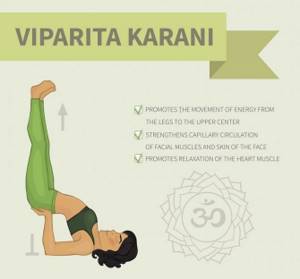
If it’s difficult to breathe calmly and you’re distracted by extraneous thoughts, use my method. When you feel yourself starting to get distracted, roll your eyes, I prefer clockwise. This is easy to do with your eyes closed. This movement of the eyeballs helps restore concentration and guides you into a conscious state in which it is easier to control your breathing and what you are doing.
Rolling your eyes is also a good way to help you get organized in everyday life, cope with irritation, anger, impatience and stress; it has an immediate sobering effect.
- Stay in this asana for 10–15 minutes. Gently push your feet off the wall, lie down a little, turn on your right side and get up from the floor.
This pose improves memory because the blood supply to the brain increases when performed. The thyroid gland and other endocrine glands are also stimulated because they are washed with fresh blood . As I already said, this is the best prevention of varicose veins . With regular practice of this pose, aging slows down, wrinkles are smoothed out, and the appearance of the skin improves. The digestive process also noticeably improves!
The bent candle pose is really very nice to do. Even thinking about this process is pleasant, let alone doing it: the body completely relaxes and rests, the sensations are indescribably wonderful, complete relaxation. I'm sure you'll want to write a thank you comment if you try the exercise at least once! I wish you good health and serene lightness in your soul.




